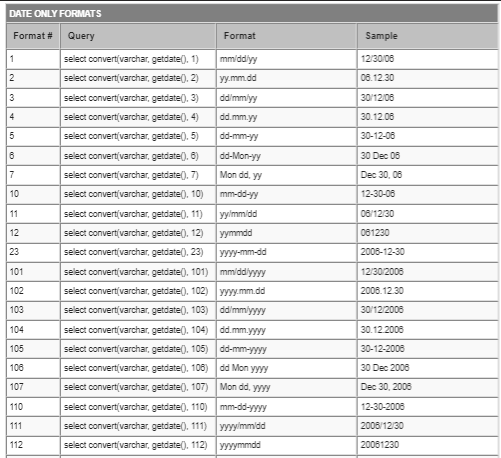SQL Individual Training - 2
like
% percent wildcard matches zero, one, or more characters
_ underscore wildcard matches a single character.
SELECT * FROM employees1 WHERE first_name LIKE 'Da%';
SELECT
employee_id, first_name, last_name
FROM
employees1
WHERE
last_name
LIKE
'%an%';
PRE- Defined Functins
SELECT UPPER('Allah-hus-samad');
SELECT REVERSE('abcd');
SELECT LEN('text');
SELECT ROUND(157.96,0)
select CAST(ROUND(10.255,2,0) AS int)
select CAST(ROUND(10.22255,2,0) AS NUMERIC(10,2))
DATE - Functions
SELECT GETDATE()
Date Parts: can use the name or listed abbreviations:
- year, yy, yyyy
- quarter, qq, q
- month, mm, m
- dayofyear, dy, y*
- day, dd, d*
- weekday, dw, w*
- week, wk, ww
- hour, hh
- minute, mi, n
- second, ss, s
- millisecond, ms
- microsecond, mcs
- nanosecond, ns
SELECT GETDATE(), MONTH(GETDATE()) , MONTH('20210101'), MONTH('2021-05-30 15:46:19.277')SELECT GETDATE(), YEAR(GETDATE()) , YEAR('20210101'), YEAR('2021-05-30 15:46:19.277');
SELECT EOMONTH(GETDATE()) as 'End Of Current Month',
EOMONTH(GETDATE(),-1) as 'End Of Last Month',
EOMONTH(GETDATE(),6) as 'End Of Month after +6 months';
SELECT DATEADD(DAY,1,'2021-01-01') as 'Add 1 Day',
DATEADD(WEEK,1,'2021-01-01') as 'Add 1 Week',
DATEADD(MONTH,1,'2021-01-01') as 'Add 1 Month',
DATEADD(YEAR,1,'2021-01-01') as 'Add 1 Year';
SELECT DATEDIFF(year, '2017/08/25', '2011/08/25')
SELECT CONVERT(CHAR(19), GETDATE(), 100) as 'Mon dd YYYY hh:mmAM';
CAST
SELECT 1 + CAST('11' AS INT) result;
SELECT CAST(5.95 AS INT) result
SELECT CAST('2019-03-14' AS DATETIME) result;
SELECT COALESCE(NULL, NULL, NULL, 'Test', NULL, 'Example.com');
IF ELSE
IF (1=1)
PRINT 'IF STATEMENT: CONDITION IS TRUE'
ELSE
PRINT 'ELSE STATEMENT: CONDITION IS FALSE'
select CAST(ROUND(10.255,2,0) AS int)
select CAST(ROUND(10.22255,2,0) AS NUMERIC(10,2))
GROUP BY
SELECT
department_id,*
FROM
employees1
GROUP
BY
department_id;
Various types of SQL aggregate functions are:
- Count()
- Sum()
- Avg()
- Min()
- Max()
SELECT
department_id,
COUNT(employee_id) headcount
FROM
employees1
GROUP BY
department_id;
SELECT
ROUND(AVG(salary), 0) avg_salary
FROM
employees1
GROUP BY department_id
SELECT
department_id, SUM(salary)
FROM
employees1
GROUP BY department_id
HAVING SUM(salary) BETWEEN 20000 AND 30000
ORDER BY SUM(salary);
constraint
NOT NULL: This constraint tells that we cannot store a null value in a column. That is, if a column is specified as NOT NULL then we will not be able to store null in this particular column any more.
UNIQUE: This constraint when specified with a column, tells that all the values in the column must be unique. That is, the values in any row of a column must not be repeated.
PRIMARY KEY: A primary key is a field which can uniquely identify each row in a table. And this constraint is used to specify a field in a table as primary key.
FOREIGN KEY: A Foreign key is a field which can uniquely identify each row in a another table. And this constraint is used to specify a field as Foreign key.
CHECK: This constraint helps to validate the values of a column to meet a particular condition. That is, it helps to ensure that the value stored in a column meets a specific condition.
DEFAULT: This constraint specifies a default value for the column when no value is specified by the user.
CHECK constraint
CREATE TABLE Student
(
ID int NOT NULL,
NAME varchar(10) NOT NULL,
AGE int NOT NULL CHECK (AGE >= 18)
);
insert into Student VALUES(1,'test',16)
DEFAULT constraint
CREATE TABLE Student2
(
ID int NOT NULL,
NAME varchar(10) NOT NULL,
DATEADDED DATE DEFAULT GETDATE()
);
insert into Student1(ID,NAME) VALUES(1,'test')






Comments
Post a Comment